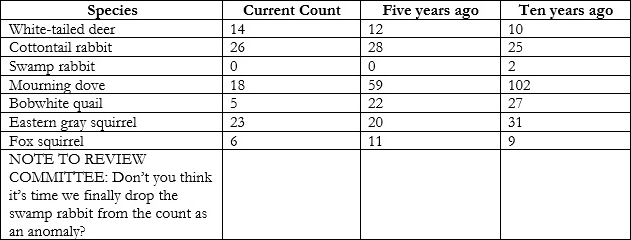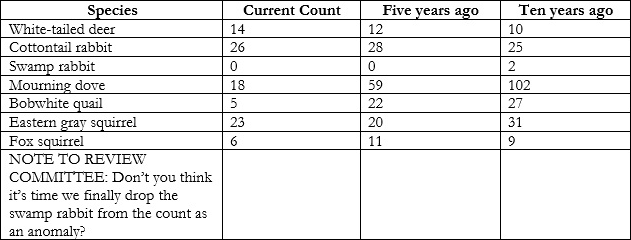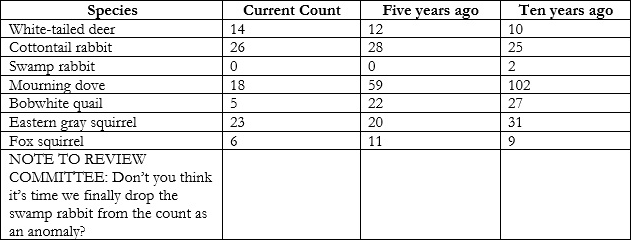Microsoft 77-725 Microsoft Word 2016 Core: Document Creation, Collaboration and Communication (MOS) Online Training
Microsoft 77-725 Online Training
The questions for 77-725 were last updated at Apr 15,2025.
- Exam Code: 77-725
- Exam Name: Microsoft Word 2016 Core: Document Creation, Collaboration and Communication (MOS)
- Certification Provider: Microsoft
- Latest update: Apr 15,2025
SIMULATION
Project 1 of 7: Observation
Overview
You are a member of the Barstow College Observation Project committee. You are preparing the initial summary report for this year’s count, but have not received all of the data you need to complete the report.

Introduction
The multi-departmental Wildlife Observation Project has completed its wildlife population counts for this year. The counts were made between May 5 and May 7 for both the wilderness and cultivated land areas. This is in line with the count periods for all previous years. The species used for the counts have been identified as common for the region (central Missouri) in which the counts were taken. (Author, 2009) As in previous years, five observation blinds were set up two weeks before the counts were to take place. Counters worked eight-hour shifts providing 24-hour coverage of the count areas for two days. Weather for both observation days was clear and mild (varying between 50-70 degrees F). The results presented here are summary total results only, which counts from five and ten years ago provided for comparison. Detailed observation results will be available as soon as they are completed. We estimate that they will be available some time in the next two weeks.
Wilderness Summary
The wilderness observation area is a five-acre section of unimproved forest land. The most common trees in the area are maple, red oak, cedar, sweet gum, and hickory. The area also includes a small spring. The area is not enclosed by a fence or other man-made barrier. The area is located eight miles from the nearest paved road and twelve miles from the nearest residence. Off-road vehicles were used to bring counters close to, but not entering, the count area. The nearest approach by off-road vehicles was one mile. The table below lists the summary counts.

Though further research any analysis is needed, the drop in mourning dove and bobwhite quail counts could be significant. The detailed count data shows these numbers failing off each year.
Cultivated Land Summary
The cultivated land observation area is a five-acre section of cultivated land near the center of a 50-acre field. The field is used to grow corn, wheat, soybeans, and clover, with the crop rotated annually. In the fifth year of the cycle, the field is left fallow. The area is located two miles from the nearest paved road and one mile from the nearest residence. A storage barn is located at the southern border of the field. The table below lists the summary counts.
Additional Notes
This project was initially scheduled to run for ten years, so we are currently in our last year. The committee needs to decide if it is worth the time and expense to continue the project. The landowners have experience that they would be happy to let us continue. Costs relating to the project is minimal and it does provide an opportunity to offer extra credit to students volunteering as counters. A suggestion has been made by some committee members that we should increase the count frequency, counting on a quarterly schedule instead of an annual schedule. This would need to be coordinated with the owner of the cultivated field so that we do not interfere with planting or harvesting schedules.
Special Thanks
Once again, we would like to offer special thanks to:
We couldn’t do this without you.
Add a table with eight rows and four columns in the “Cultivated Land Summary” section, below the text “The table below lists the summary counts.”
SIMULATION
Project 1 of 7: Observation
Overview
You are a member of the Barstow College Observation Project committee. You are preparing the initial summary report for this year’s count, but have not received all of the data you need to complete the report.

Introduction
The multi-departmental Wildlife Observation Project has completed its wildlife population counts for this year. The counts were made between May 5 and May 7 for both the wilderness and cultivated land areas. This is in line with the count periods for all previous years. The species used for the counts have been identified as common for the region (central Missouri) in which the counts were taken. (Author, 2009) As in previous years, five observation blinds were set up two weeks before the counts were to take place. Counters worked eight-hour shifts providing 24-hour coverage of the count areas for two days. Weather for both observation days was clear and mild (varying between 50-70 degrees F). The results presented here are summary total results only, which counts from five and ten years ago provided for comparison. Detailed observation results will be available as soon as they are completed. We estimate that they will be available some time in the next two weeks.
Wilderness Summary
The wilderness observation area is a five-acre section of unimproved forest land. The most common trees in the area are maple, red oak, cedar, sweet gum, and hickory. The area also includes a small spring. The area is not enclosed by a fence or other man-made barrier. The area is located eight miles from the nearest paved road and twelve miles from the nearest residence. Off-road vehicles were used to bring counters close to, but not entering, the count area. The nearest approach by off-road vehicles was one mile. The table below lists the summary counts.

Though further research any analysis is needed, the drop in mourning dove and bobwhite quail counts could be significant. The detailed count data shows these numbers failing off each year.
Cultivated Land Summary
The cultivated land observation area is a five-acre section of cultivated land near the center of a 50-acre field. The field is used to grow corn, wheat, soybeans, and clover, with the crop rotated annually. In the fifth year of the cycle, the field is left fallow. The area is located two miles from the nearest paved road and one mile from the nearest residence. A storage barn is located at the southern border of the field. The table below lists the summary counts.
Additional Notes
This project was initially scheduled to run for ten years, so we are currently in our last year. The committee needs to decide if it is worth the time and expense to continue the project. The landowners have experience that they would be happy to let us continue. Costs relating to the project is minimal and it does provide an opportunity to offer extra credit to students volunteering as counters. A suggestion has been made by some committee members that we should increase the count frequency, counting on a quarterly schedule instead of an annual schedule. This would need to be coordinated with the owner of the cultivated field so that we do not interfere with planting or harvesting schedules.
Special Thanks
Once again, we would like to offer special thanks to:
We couldn’t do this without you.
Merge all cells in the bottom row of the table below the “Wilderness Summary” heading into one cell.
SIMULATION
Project 1 of 7: Observation
Overview
You are a member of the Barstow College Observation Project committee. You are preparing the initial summary report for this year’s count, but have not received all of the data you need to complete the report.

Introduction
The multi-departmental Wildlife Observation Project has completed its wildlife population counts for this year. The counts were made between May 5 and May 7 for both the wilderness and cultivated land areas. This is in line with the count periods for all previous years. The species used for the counts have been identified as common for the region (central Missouri) in which the counts were taken. (Author, 2009) As in previous years, five observation blinds were set up two weeks before the counts were to take place. Counters worked eight-hour shifts providing 24-hour coverage of the count areas for two days. Weather for both observation days was clear and mild (varying between 50-70 degrees F). The results presented here are summary total results only, which counts from five and ten years ago provided for comparison. Detailed observation results will be available as soon as they are completed. We estimate that they will be available some time in the next two weeks.
Wilderness Summary
The wilderness observation area is a five-acre section of unimproved forest land. The most common trees in the area are maple, red oak, cedar, sweet gum, and hickory. The area also includes a small spring. The area is not enclosed by a fence or other man-made barrier. The area is located eight miles from the nearest paved road and twelve miles from the nearest residence. Off-road vehicles were used to bring counters close to, but not entering, the count area. The nearest approach by off-road vehicles was one mile. The table below lists the summary counts.

Though further research any analysis is needed, the drop in mourning dove and bobwhite quail counts could be significant. The detailed count data shows these numbers failing off each year.
Cultivated Land Summary
The cultivated land observation area is a five-acre section of cultivated land near the center of a 50-acre field. The field is used to grow corn, wheat, soybeans, and clover, with the crop rotated annually. In the fifth year of the cycle, the field is left fallow. The area is located two miles from the nearest paved road and one mile from the nearest residence. A storage barn is located at the southern border of the field. The table below lists the summary counts.
Additional Notes
This project was initially scheduled to run for ten years, so we are currently in our last year. The committee needs to decide if it is worth the time and expense to continue the project. The landowners have experience that they would be happy to let us continue. Costs relating to the project is minimal and it does provide an opportunity to offer extra credit to students volunteering as counters. A suggestion has been made by some committee members that we should increase the count frequency, counting on a quarterly schedule instead of an annual schedule. This would need to be coordinated with the owner of the cultivated field so that we do not interfere with planting or harvesting schedules.
Special Thanks
Once again, we would like to offer special thanks to:
We couldn’t do this without you.
Merge all cells in the bottom row of the table below the “Wilderness Summary” heading into one cell.
SIMULATION
Project 1 of 7: Observation
Overview
You are a member of the Barstow College Observation Project committee. You are preparing the initial summary report for this year’s count, but have not received all of the data you need to complete the report.

Introduction
The multi-departmental Wildlife Observation Project has completed its wildlife population counts for this year. The counts were made between May 5 and May 7 for both the wilderness and cultivated land areas. This is in line with the count periods for all previous years. The species used for the counts have been identified as common for the region (central Missouri) in which the counts were taken. (Author, 2009) As in previous years, five observation blinds were set up two weeks before the counts were to take place. Counters worked eight-hour shifts providing 24-hour coverage of the count areas for two days. Weather for both observation days was clear and mild (varying between 50-70 degrees F). The results presented here are summary total results only, which counts from five and ten years ago provided for comparison. Detailed observation results will be available as soon as they are completed. We estimate that they will be available some time in the next two weeks.
Wilderness Summary
The wilderness observation area is a five-acre section of unimproved forest land. The most common trees in the area are maple, red oak, cedar, sweet gum, and hickory. The area also includes a small spring. The area is not enclosed by a fence or other man-made barrier. The area is located eight miles from the nearest paved road and twelve miles from the nearest residence. Off-road vehicles were used to bring counters close to, but not entering, the count area. The nearest approach by off-road vehicles was one mile. The table below lists the summary counts.

Though further research any analysis is needed, the drop in mourning dove and bobwhite quail counts could be significant. The detailed count data shows these numbers failing off each year.
Cultivated Land Summary
The cultivated land observation area is a five-acre section of cultivated land near the center of a 50-acre field. The field is used to grow corn, wheat, soybeans, and clover, with the crop rotated annually. In the fifth year of the cycle, the field is left fallow. The area is located two miles from the nearest paved road and one mile from the nearest residence. A storage barn is located at the southern border of the field. The table below lists the summary counts.
Additional Notes
This project was initially scheduled to run for ten years, so we are currently in our last year. The committee needs to decide if it is worth the time and expense to continue the project. The landowners have experience that they would be happy to let us continue. Costs relating to the project is minimal and it does provide an opportunity to offer extra credit to students volunteering as counters. A suggestion has been made by some committee members that we should increase the count frequency, counting on a quarterly schedule instead of an annual schedule. This would need to be coordinated with the owner of the cultivated field so that we do not interfere with planting or harvesting schedules.
Special Thanks
Once again, we would like to offer special thanks to:
We couldn’t do this without you.
Merge all cells in the bottom row of the table below the “Wilderness Summary” heading into one cell.
SIMULATION
Project 1 of 7: Observation
Overview
You are a member of the Barstow College Observation Project committee. You are preparing the initial summary report for this year’s count, but have not received all of the data you need to complete the report.

Introduction
The multi-departmental Wildlife Observation Project has completed its wildlife population counts for this year. The counts were made between May 5 and May 7 for both the wilderness and cultivated land areas. This is in line with the count periods for all previous years. The species used for the counts have been identified as common for the region (central Missouri) in which the counts were taken. (Author, 2009) As in previous years, five observation blinds were set up two weeks before the counts were to take place. Counters worked eight-hour shifts providing 24-hour coverage of the count areas for two days. Weather for both observation days was clear and mild (varying between 50-70 degrees F). The results presented here are summary total results only, which counts from five and ten years ago provided for comparison. Detailed observation results will be available as soon as they are completed. We estimate that they will be available some time in the next two weeks.
Wilderness Summary
The wilderness observation area is a five-acre section of unimproved forest land. The most common trees in the area are maple, red oak, cedar, sweet gum, and hickory. The area also includes a small spring. The area is not enclosed by a fence or other man-made barrier. The area is located eight miles from the nearest paved road and twelve miles from the nearest residence. Off-road vehicles were used to bring counters close to, but not entering, the count area. The nearest approach by off-road vehicles was one mile. The table below lists the summary counts.

Though further research any analysis is needed, the drop in mourning dove and bobwhite quail counts could be significant. The detailed count data shows these numbers failing off each year.
Cultivated Land Summary
The cultivated land observation area is a five-acre section of cultivated land near the center of a 50-acre field. The field is used to grow corn, wheat, soybeans, and clover, with the crop rotated annually. In the fifth year of the cycle, the field is left fallow. The area is located two miles from the nearest paved road and one mile from the nearest residence. A storage barn is located at the southern border of the field. The table below lists the summary counts.
Additional Notes
This project was initially scheduled to run for ten years, so we are currently in our last year. The committee needs to decide if it is worth the time and expense to continue the project. The landowners have experience that they would be happy to let us continue. Costs relating to the project is minimal and it does provide an opportunity to offer extra credit to students volunteering as counters. A suggestion has been made by some committee members that we should increase the count frequency, counting on a quarterly schedule instead of an annual schedule. This would need to be coordinated with the owner of the cultivated field so that we do not interfere with planting or harvesting schedules.
Special Thanks
Once again, we would like to offer special thanks to:
We couldn’t do this without you.
Merge all cells in the bottom row of the table below the “Wilderness Summary” heading into one cell.
SIMULATION
Project 1 of 7: Observation
Overview
You are a member of the Barstow College Observation Project committee. You are preparing the initial summary report for this year’s count, but have not received all of the data you need to complete the report.

Introduction
The multi-departmental Wildlife Observation Project has completed its wildlife population counts for this year. The counts were made between May 5 and May 7 for both the wilderness and cultivated land areas. This is in line with the count periods for all previous years. The species used for the counts have been identified as common for the region (central Missouri) in which the counts were taken. (Author, 2009) As in previous years, five observation blinds were set up two weeks before the counts were to take place. Counters worked eight-hour shifts providing 24-hour coverage of the count areas for two days. Weather for both observation days was clear and mild (varying between 50-70 degrees F). The results presented here are summary total results only, which counts from five and ten years ago provided for comparison. Detailed observation results will be available as soon as they are completed. We estimate that they will be available some time in the next two weeks.
Wilderness Summary
The wilderness observation area is a five-acre section of unimproved forest land. The most common trees in the area are maple, red oak, cedar, sweet gum, and hickory. The area also includes a small spring. The area is not enclosed by a fence or other man-made barrier. The area is located eight miles from the nearest paved road and twelve miles from the nearest residence. Off-road vehicles were used to bring counters close to, but not entering, the count area. The nearest approach by off-road vehicles was one mile. The table below lists the summary counts.

Though further research any analysis is needed, the drop in mourning dove and bobwhite quail counts could be significant. The detailed count data shows these numbers failing off each year.
Cultivated Land Summary
The cultivated land observation area is a five-acre section of cultivated land near the center of a 50-acre field. The field is used to grow corn, wheat, soybeans, and clover, with the crop rotated annually. In the fifth year of the cycle, the field is left fallow. The area is located two miles from the nearest paved road and one mile from the nearest residence. A storage barn is located at the southern border of the field. The table below lists the summary counts.
Additional Notes
This project was initially scheduled to run for ten years, so we are currently in our last year. The committee needs to decide if it is worth the time and expense to continue the project. The landowners have experience that they would be happy to let us continue. Costs relating to the project is minimal and it does provide an opportunity to offer extra credit to students volunteering as counters. A suggestion has been made by some committee members that we should increase the count frequency, counting on a quarterly schedule instead of an annual schedule. This would need to be coordinated with the owner of the cultivated field so that we do not interfere with planting or harvesting schedules.
Special Thanks
Once again, we would like to offer special thanks to:
We couldn’t do this without you.
Merge all cells in the bottom row of the table below the “Wilderness Summary” heading into one cell.
SIMULATION
Project 1 of 7: Observation
Overview
You are a member of the Barstow College Observation Project committee. You are preparing the initial summary report for this year’s count, but have not received all of the data you need to complete the report.

Introduction
The multi-departmental Wildlife Observation Project has completed its wildlife population counts for this year. The counts were made between May 5 and May 7 for both the wilderness and cultivated land areas. This is in line with the count periods for all previous years. The species used for the counts have been identified as common for the region (central Missouri) in which the counts were taken. (Author, 2009) As in previous years, five observation blinds were set up two weeks before the counts were to take place. Counters worked eight-hour shifts providing 24-hour coverage of the count areas for two days. Weather for both observation days was clear and mild (varying between 50-70 degrees F). The results presented here are summary total results only, which counts from five and ten years ago provided for comparison. Detailed observation results will be available as soon as they are completed. We estimate that they will be available some time in the next two weeks.
Wilderness Summary
The wilderness observation area is a five-acre section of unimproved forest land. The most common trees in the area are maple, red oak, cedar, sweet gum, and hickory. The area also includes a small spring. The area is not enclosed by a fence or other man-made barrier. The area is located eight miles from the nearest paved road and twelve miles from the nearest residence. Off-road vehicles were used to bring counters close to, but not entering, the count area. The nearest approach by off-road vehicles was one mile. The table below lists the summary counts.

Though further research any analysis is needed, the drop in mourning dove and bobwhite quail counts could be significant. The detailed count data shows these numbers failing off each year.
Cultivated Land Summary
The cultivated land observation area is a five-acre section of cultivated land near the center of a 50-acre field. The field is used to grow corn, wheat, soybeans, and clover, with the crop rotated annually. In the fifth year of the cycle, the field is left fallow. The area is located two miles from the nearest paved road and one mile from the nearest residence. A storage barn is located at the southern border of the field. The table below lists the summary counts.
Additional Notes
This project was initially scheduled to run for ten years, so we are currently in our last year. The committee needs to decide if it is worth the time and expense to continue the project. The landowners have experience that they would be happy to let us continue. Costs relating to the project is minimal and it does provide an opportunity to offer extra credit to students volunteering as counters. A suggestion has been made by some committee members that we should increase the count frequency, counting on a quarterly schedule instead of an annual schedule. This would need to be coordinated with the owner of the cultivated field so that we do not interfere with planting or harvesting schedules.
Special Thanks
Once again, we would like to offer special thanks to:
We couldn’t do this without you.
In the table below the “Wilderness Summary”, adjust the column width so that all columns are the same width.
SIMULATION
Project 1 of 7: Observation
Overview
You are a member of the Barstow College Observation Project committee. You are preparing the initial summary report for this year’s count, but have not received all of the data you need to complete the report.

Introduction
The multi-departmental Wildlife Observation Project has completed its wildlife population counts for this year. The counts were made between May 5 and May 7 for both the wilderness and cultivated land areas. This is in line with the count periods for all previous years. The species used for the counts have been identified as common for the region (central Missouri) in which the counts were taken. (Author, 2009) As in previous years, five observation blinds were set up two weeks before the counts were to take place. Counters worked eight-hour shifts providing 24-hour coverage of the count areas for two days. Weather for both observation days was clear and mild (varying between 50-70 degrees F). The results presented here are summary total results only, which counts from five and ten years ago provided for comparison. Detailed observation results will be available as soon as they are completed. We estimate that they will be available some time in the next two weeks.
Wilderness Summary
The wilderness observation area is a five-acre section of unimproved forest land. The most common trees in the area are maple, red oak, cedar, sweet gum, and hickory. The area also includes a small spring. The area is not enclosed by a fence or other man-made barrier. The area is located eight miles from the nearest paved road and twelve miles from the nearest residence. Off-road vehicles were used to bring counters close to, but not entering, the count area. The nearest approach by off-road vehicles was one mile. The table below lists the summary counts.

Though further research any analysis is needed, the drop in mourning dove and bobwhite quail counts could be significant. The detailed count data shows these numbers failing off each year.
Cultivated Land Summary
The cultivated land observation area is a five-acre section of cultivated land near the center of a 50-acre field. The field is used to grow corn, wheat, soybeans, and clover, with the crop rotated annually. In the fifth year of the cycle, the field is left fallow. The area is located two miles from the nearest paved road and one mile from the nearest residence. A storage barn is located at the southern border of the field. The table below lists the summary counts.
Additional Notes
This project was initially scheduled to run for ten years, so we are currently in our last year. The committee needs to decide if it is worth the time and expense to continue the project. The landowners have experience that they would be happy to let us continue. Costs relating to the project is minimal and it does provide an opportunity to offer extra credit to students volunteering as counters. A suggestion has been made by some committee members that we should increase the count frequency, counting on a quarterly schedule instead of an annual schedule. This would need to be coordinated with the owner of the cultivated field so that we do not interfere with planting or harvesting schedules.
Special Thanks
Once again, we would like to offer special thanks to:
We couldn’t do this without you.
In the table below the “Wilderness Summary”, adjust the column width so that all columns are the same width.
SIMULATION
Project 1 of 7: Observation
Overview
You are a member of the Barstow College Observation Project committee. You are preparing the initial summary report for this year’s count, but have not received all of the data you need to complete the report.

Introduction
The multi-departmental Wildlife Observation Project has completed its wildlife population counts for this year. The counts were made between May 5 and May 7 for both the wilderness and cultivated land areas. This is in line with the count periods for all previous years. The species used for the counts have been identified as common for the region (central Missouri) in which the counts were taken. (Author, 2009) As in previous years, five observation blinds were set up two weeks before the counts were to take place. Counters worked eight-hour shifts providing 24-hour coverage of the count areas for two days. Weather for both observation days was clear and mild (varying between 50-70 degrees F). The results presented here are summary total results only, which counts from five and ten years ago provided for comparison. Detailed observation results will be available as soon as they are completed. We estimate that they will be available some time in the next two weeks.
Wilderness Summary
The wilderness observation area is a five-acre section of unimproved forest land. The most common trees in the area are maple, red oak, cedar, sweet gum, and hickory. The area also includes a small spring. The area is not enclosed by a fence or other man-made barrier. The area is located eight miles from the nearest paved road and twelve miles from the nearest residence. Off-road vehicles were used to bring counters close to, but not entering, the count area. The nearest approach by off-road vehicles was one mile. The table below lists the summary counts.

Though further research any analysis is needed, the drop in mourning dove and bobwhite quail counts could be significant. The detailed count data shows these numbers failing off each year.
Cultivated Land Summary
The cultivated land observation area is a five-acre section of cultivated land near the center of a 50-acre field. The field is used to grow corn, wheat, soybeans, and clover, with the crop rotated annually. In the fifth year of the cycle, the field is left fallow. The area is located two miles from the nearest paved road and one mile from the nearest residence. A storage barn is located at the southern border of the field. The table below lists the summary counts.
Additional Notes
This project was initially scheduled to run for ten years, so we are currently in our last year. The committee needs to decide if it is worth the time and expense to continue the project. The landowners have experience that they would be happy to let us continue. Costs relating to the project is minimal and it does provide an opportunity to offer extra credit to students volunteering as counters. A suggestion has been made by some committee members that we should increase the count frequency, counting on a quarterly schedule instead of an annual schedule. This would need to be coordinated with the owner of the cultivated field so that we do not interfere with planting or harvesting schedules.
Special Thanks
Once again, we would like to offer special thanks to:
We couldn’t do this without you.
In the table below the “Wilderness Summary”, adjust the column width so that all columns are the same width.
SIMULATION
Project 1 of 7: Observation
Overview
You are a member of the Barstow College Observation Project committee. You are preparing the initial summary report for this year’s count, but have not received all of the data you need to complete the report.

Introduction
The multi-departmental Wildlife Observation Project has completed its wildlife population counts for this year. The counts were made between May 5 and May 7 for both the wilderness and cultivated land areas. This is in line with the count periods for all previous years. The species used for the counts have been identified as common for the region (central Missouri) in which the counts were taken. (Author, 2009) As in previous years, five observation blinds were set up two weeks before the counts were to take place. Counters worked eight-hour shifts providing 24-hour coverage of the count areas for two days. Weather for both observation days was clear and mild (varying between 50-70 degrees F). The results presented here are summary total results only, which counts from five and ten years ago provided for comparison. Detailed observation results will be available as soon as they are completed. We estimate that they will be available some time in the next two weeks.
Wilderness Summary
The wilderness observation area is a five-acre section of unimproved forest land. The most common trees in the area are maple, red oak, cedar, sweet gum, and hickory. The area also includes a small spring. The area is not enclosed by a fence or other man-made barrier. The area is located eight miles from the nearest paved road and twelve miles from the nearest residence. Off-road vehicles were used to bring counters close to, but not entering, the count area. The nearest approach by off-road vehicles was one mile. The table below lists the summary counts.

Though further research any analysis is needed, the drop in mourning dove and bobwhite quail counts could be significant. The detailed count data shows these numbers failing off each year.
Cultivated Land Summary
The cultivated land observation area is a five-acre section of cultivated land near the center of a 50-acre field. The field is used to grow corn, wheat, soybeans, and clover, with the crop rotated annually. In the fifth year of the cycle, the field is left fallow. The area is located two miles from the nearest paved road and one mile from the nearest residence. A storage barn is located at the southern border of the field. The table below lists the summary counts.
Additional Notes
This project was initially scheduled to run for ten years, so we are currently in our last year. The committee needs to decide if it is worth the time and expense to continue the project. The landowners have experience that they would be happy to let us continue. Costs relating to the project is minimal and it does provide an opportunity to offer extra credit to students volunteering as counters. A suggestion has been made by some committee members that we should increase the count frequency, counting on a quarterly schedule instead of an annual schedule. This would need to be coordinated with the owner of the cultivated field so that we do not interfere with planting or harvesting schedules.
Special Thanks
Once again, we would like to offer special thanks to:
We couldn’t do this without you.
In the table below the “Wilderness Summary”, adjust the column width so that all columns are the same width.
Latest 77-725 Dumps Valid Version with 35 Q&As
Latest And Valid Q&A | Instant Download | Once Fail, Full Refund

